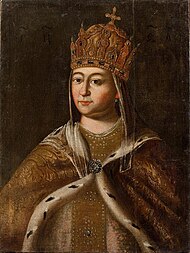Eudoxia Lukyanovna Streshneva
| Eudoxia Streshnyova | |
|---|---|
 |
|
| Tsaritsa consort of All Russia | |
| Tenure | 5 February 1626 – 12 July 1645 |
| Born | c. 1608 Meshchovsk |
| Died | 18 August 1645 (aged 36–37) Moscow |
| Burial | Ascension Convent, Kolomenskoye Archangel Cathedral, Kremlin (1929) |
| Spouse | Michael of Russia |
| Issue among others... |
Tsarevna Irina Mikhailovna Alexis |
| House | Romanov |
| Father | Lukyan Stepanovich Streshnyov |
| Mother | Anna Konstantinovna Volkonskaya |
| Religion | Eastern Orthodox |
Eudoxia Streshnyova (Russian: Евдоки́я Лукья́новна Стрешнёва, Yevdokiya Lukyanovna Streshnyova) (1608 – 18 August 1645) was the tsaritsa of Russia as the second spouse of tsar Michael of Russia.
Eudoxia Streshnyova was a daughter of the noble Lukyan Stepanovich Streshnyov (d. 1630) from Mozhaysk and Anna Konstantinovna Volkonskaya. Her mother died shortly after birth, and her father left home to serve in the military. She was thus regarded almost an orphan, and raised by a rich relative who belonged to the circle of the tsar's court in Moscow.
Eudoxia Streshnyova was among those daughter's of the nobility summoned to appear in the Bride-show at court, when the tsar was to select his new tsaritsa, after his first spouse had died. Tsar Michael did not like any of those selected for him to choose from, but was pressed by his parents to make a choice. He eventually chose Yevdokiya because of her beauty, polite behavior and mild disposition.
The parent's of the tsar was reportedly displeased with his choice. His mother, Xenia Shestova, claimed that Streshnyova was not of an important enough family, and that he risked to anger all the most high ranked noble families by choosing a bride from a family of a lower rank then them.
However, the tsar refused to change his mind. He did not only refer to his feelings, but also to his Christian duty to help a girl who would otherwise be forced to leave court and anger her family. She was described as a modest and virtuous girl, dominated by her proud relatives, who sometimes brought her to tears but still did not complain. Reportedly, the tsar was moved by her situation and felt sorry for her.
The wedding was conducted on 5 February 1626. As was the custom, Eudoxia was given the title of Tsaritsa prior to the wedding, but only three days before the wedding, which was a much shorter time period than usual. Her parents-in-law both participated in the ceremony. They wished to change her name to Anastasia from the tsaritsa of tsar Ivan, but she successfully refused. After the wedding, she was given several land, and gave her a substantial fortune of her own.
As tsaritsa, Eudoxia Streshneva lived secluded from contact with men, as was expected from a Russian noblewoman at the time, but despite this, she was also expected to participate in public religious and charitable duties and manage the imperial household.
Tsaritsa Eudoxia was known to have been in a difficult situation in the imperial court because of her mother-in-law, Xenia Shestova, who dominated her and the life of the imperial court. She and her mother-in-law shared the same confessor and diak. Xenia Shestova accompanied her daughter-in-law during all her official visits to monasteries and churches, and managed her public life as a tsaritsa. She also chose tutors for her grandchildren, dominating her relationship to them. Eudoxia never managed to achieve any influence over tsar Mikhail, either during or after the death of her mother-in-law.
...
Wikipedia
